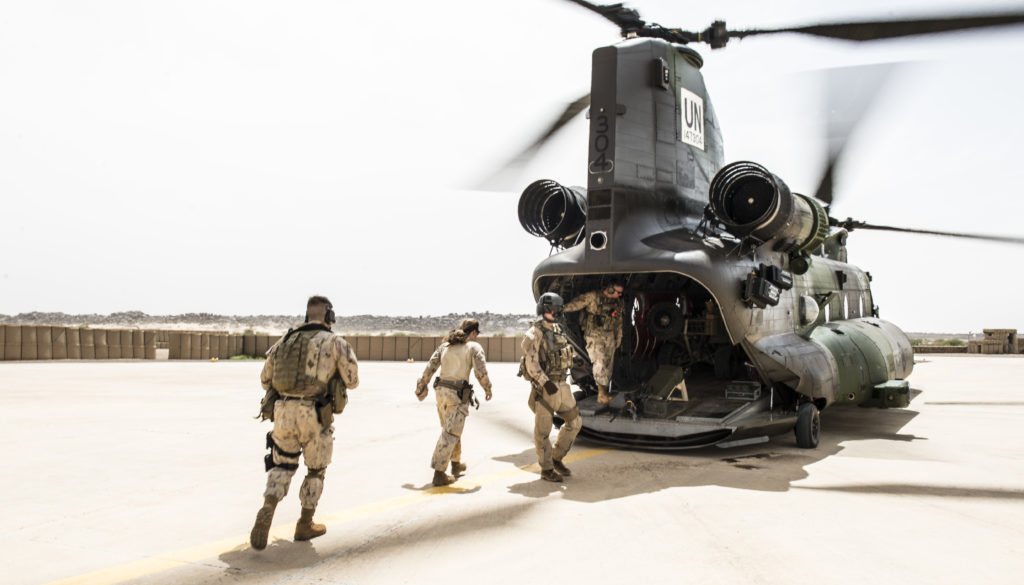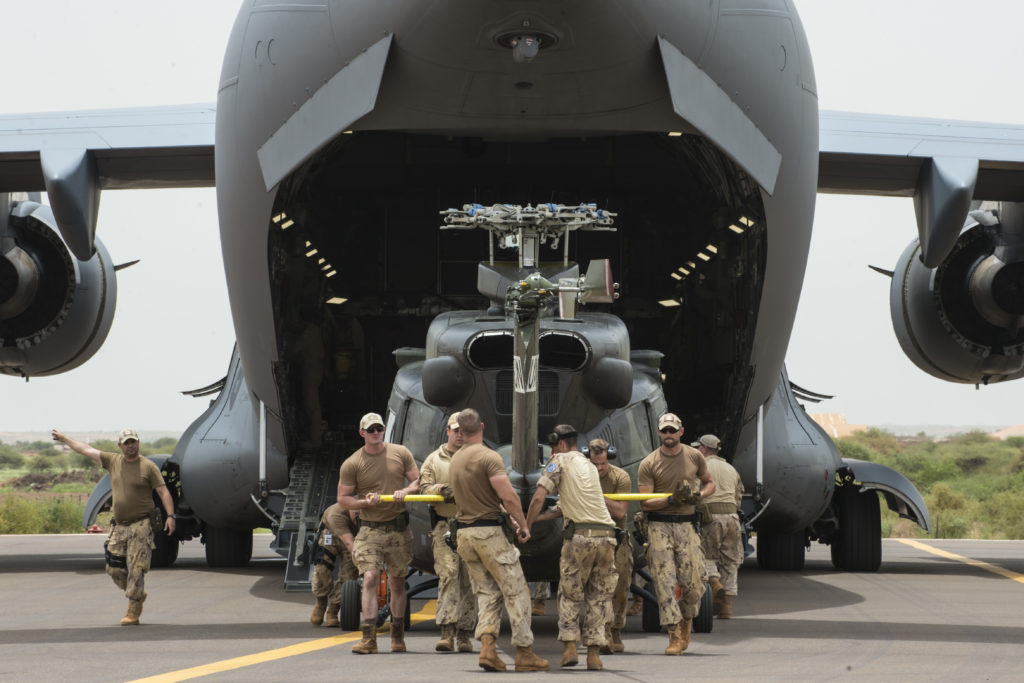Estimated reading time 7 minutes, 48 seconds.
With heavy rains hampering the movement of United Nations personnel by road, Canadian CH-146 Griffon and CH-147 Chinook helicopters have begun transporting troops to underserved regions of Mali.

The Canadian Armed Forces (CAF) joint task force declared full operational capability (FOC) on Aug. 15 and the aviation detachment of three Boeing Chinooks and five Bell Griffons immediately embarked on its first mission, ferrying Dutch soldiers about 100 kilometres northeast of their base camp near the city of Gao. A second similar “presence projection” mission of a Chinook and two Griffon escorts was conducted three days later on Aug. 18.
“We moved a platoon of soldiers and some ATVs near a village and allowed them to engage with the local population and [develop] an idea of what their needs are,” said Col Chris McKenna, the task force commander.
Severe thunderstorms and heavy rain–as much as 40 to 50 millimetres at times–have washed out some roads and made driving conditions difficult and dangerous for UN troops, he said, making air transport a much safer option.
The 250-person joint task force, comprised of a headquarters staff, an aviation detachment, and maintenance, logistics and support personnel, declared initial operating capability on Aug. 1, shortly after arriving in Gao. That meant a Chinook and two Griffons on 24/7 standby to respond to any incident requiring medical evacuation.

But crews still had to complete theatre-specific training and qualifications and all equipment had to be airlifted into the base before the task force could declare FOC. The last of the Griffons arrived on Saturday, Aug 25. A CC-130J Hercules has airlifted equipment from an operational support hub based in Dakar, Senegal.
Most missions to date have been utility aviation, moving cargo and people between forward operating bases. The transport of the Dutch soldiers was the first “deliberate” mission, involving planning and mission rehearsal.
Fortunately, the task force has yet to conduct the mission the Royal Canadian Air Force (RCAF), the Canadian Army and CAF Health Services spent months developing and validating in Petawawa, Ont., and Wainwright, Alta., prior to deployment–forward aeromedical evacuation.
Two Griffons were launched and the Chinook was readied in response to a possible improvised-explosive device strike on an Egyptian convoy, but the incident turned out to be a truck fire.
Prior to deploying, the Air Force, working with CAF Health Services and Army infantry, validated forward aeromedical evacuation capability for the Chinooks.
“We have not evacuated anyone yet, but we’re ready everyday,” said McKenna, noting that the persistent rain has limited mobility for everyone.

The air medevac crews have remained sharp through regular launch drills several times a week. McKenna said the concept, mandated in July 2017 by the chief of the defence staff and first trialed earlier this year under snowy conditions in eastern Ontario, has gelled better than expected.
The medical teams consist of 13 personnel: a trauma doctor, a critical care nurse, two aeromedical technicians, four infantry soldiers to provide on-the-ground- force protection, and the five-person Chinook crew.
“We validated it here,” he said. “Those folks are on 24/7 standby and we rotate crews through a bit of a three-day cycle. They do a day on standby, a day planning, and then a day flying the utility missions.”
The force protection teams are from the Royal 22nd Regiment, better known to some as Van Doos, and have quickly integrated into the critical care team, providing a secure perimeter when the medical personnel disembark to treat the injured and an extra pair of hands once everyone is back on the aircraft.
“It has created this really neat eight-person med team in the back,” said McKenna. “All four of those infantry folks are very well armed, but they are also well trained in the medical side of things. They do a three-week tactical combat casualty care course…and [they are able] to work under the supervision of a clinician in the back of the Chinook.”
The Mali mission marks the first time the Griffon and Chinook helicopters have deployed together, and therefore the first time the RCAF has operationalized its tactical aviation force employment concept, introduced in 2014 and refined over the past several years.
The aviation detachment consists of about 185 personnel. The command team and Griffons are from 408 Tactical Helicopter Squadron in Edmonton, while the Chinooks are from 450 THS in Petawawa. Both squadrons have also brought maintenance, logistics and other support personnel.
McKenna, who was commander of 450 THS when the employment concept was developed, said, “integrating the Chinook and the Griffon together has gone better than I had anticipated.
“The time we had together in Wainwright to validate the specific forward air evac concepts was very helpful. And the way we are being employed here lends itself to a lot of great team work between the elements of the task force. I very happy to see it all play out the way we planned it. It’s working out better than I had envisioned.”
The Griffon might be the slower of the two helicopters, an awkward situation for an escort bird, but it is able to launch quicker and can “get on top of an incident site to make sure it is safe to bring the Chinook in,” said McKenna.
“We’re in an environment 3,000 feet lower than Kandahar [Afghanistan], so the speed mismatch is not as big an issue,” he added. Suffice to say [the Griffons] have all the firepower they need to defend the Chinook and to defend themselves as well. It is a very good package and its had validated for me our concepts–the way we are employing it is going to be very useful.”
Since the joint task force arrived in Gao at the end of July, aircrews have seen a transformation in the landscape. What began as flights over dusty brown deserts has, with the heavy rains, changed to large swaths of green scrub.
“[The rain] has caused the desert to come alive,” said McKenna, who was out flying the day before he spoke with Skies. “There are little trees everywhere and the desert is no longer a desert…between Gao and Kidal, it’s very green, with lots of wildlife. It’s a beautiful country.”








